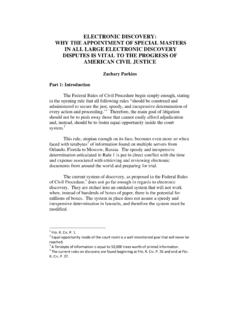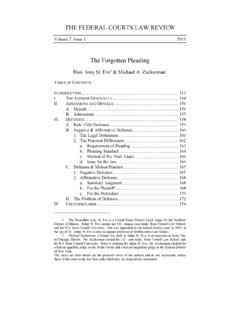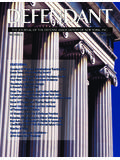Transcription of PCLLConversion.com Sample - Hong Kong Civil …
1 Q u i c k , e a s y a n d e f f e c t i v e n o t e s f o r P C L L C o n v e r s i o n E x a m i n a t i o n s ! H o n g K o n g C i v i l P r o c e d u r e N o t e s Copyright 2018 Page 1 hong kong Civil Procedure Notes 2018 1st Edition Q u i c k , e a s y a n d e f f e c t i v e n o t e s f o r P C L L C o n v e r s i o n E x a m i n a t i o n s ! H o n g K o n g C i v i l P r o c e d u r e N o t e s Copyright 2018 Page 2 TABLE OF CONTENTS 1. INTRODUCTION .. 6 A. How to use Conversion Notes .. 6 B. Abbreviations .. 6 2. OVERVIEW OF THE CONDUCT OF Civil LITIGATION IN THE DISTRICT COURT AND THE HIGH COURT 7 A. Jurisdiction of the District Court .. 7 B. Jurisdiction of the High Court .. 7 C. Transfer of an action between the district court and the high court .. 7 3. CONSIDERATION PRIOR TO THE COMMENCEMENT OF AN ACTION: TIME LIMITATION, LEGAL AID AND JURISDICTION OF THE COURTS.
2 7 A. Limitation Period .. 7 B. Costs only proceedings .. 8 C. Legal Aid .. 8 i. Type of proceedings .. 9 ii. Eligibility .. 9 iii. Costs implication if a party is legally 10 4. UNDERLYING OBJECTIVES OF THE HIGH COURT AND DISTRICT COURT RULES .. 10 A. The courts underlying objectives .. 10 B. The courts case management powers .. 10 5. COMMENCEMENT OF PROCEEDINGS BY WRITS AND ORIGINATING SUMMONSES .. 10 A. Methods of commencing proceedings .. 10 i. Writ of Summons .. 11 B. Validity and renewal of the writ .. 12 6. SERVICE OF PROCESS .. 12 A. Service within the jurisdiction .. 12 B. Service on individuals .. 12 i. Service through letter box or registered box .. 12 ii. service through defendant s solicitor .. 13 iii. deemed service where writ not duly served .. 13 iv. Service on agent of overseas principal .. 13 v. Service pursuant to contract .. 13 vi. Service by agreement of parties .. 13 C. Service on body corporate.
3 13 i. Company registered under Companies Ordinance .. 13 1) Company with registered office .. 13 2) Company with no registered office .. 14 ii. Service on overseas company carrying on business in HK .. 14 D. Service on partnership .. 14 E. Substituted service .. 15 F. Service on persons under disability .. 15 Q u i c k , e a s y a n d e f f e c t i v e n o t e s f o r P C L L C o n v e r s i o n E x a m i n a t i o n s ! H o n g K o n g C i v i l P r o c e d u r e N o t e s Copyright 2018 Page 3 G. Service out of the jurisdiction .. 15 H. Acknowledgement of 16 7. PLEADINGS .. 16 A. The definition and purpose of pleadings .. 16 B. The order of pleadings .. 16 i. Statement of Claim .. 16 ii. Defence and Counterclaim .. 16 iii. Reply and Defence to Counterclaim .. 17 iv. Close of pleadings .. 17 C. General rules of pleadings .. 17 D. Verification by Statement of Truth.
4 17 E. The purpose of further and better particulars .. 18 8. PARTIES AND JOINDER .. 18 A. Third party proceedings .. 18 i. Leave and Third party notice .. 18 ii. rights and obligations of the third party .. 19 iii. position of the defendant and the third party .. 19 iv. Third party directions .. 19 B. contribution 20 C. Joinder of parties by plaintiff/by defendant/by the court .. 20 i. mandatory joinder of plaintiffs .. 20 ii. legal representatives of joined plaintiffs .. 20 iii. optional joinder of parties .. 20 iv. joinder of defendants who are jointly and/or severally liable .. 21 v. overriding discretion of the court .. 21 D. Joinder of causes of action .. 21 E. Consolidation of actions or order for separate trials .. 22 i. 22 ii. separate trial .. 22 F. The interpleader procedure .. 22 9. SUMMARY DISPOSAL OF ACTIONS: DEFAULT JUDGMENT AND SUMMARY JUDGMENT .. 23 A. Summary judgment: general principles .. 23 B. Summary judgment: timing and procedure.
5 24 C. Summary judgment: possible outcomes and the appeal procedure .. 24 i. Granting Summary Judgment .. 24 ii. Leave to defend .. 24 iii. Dismiss the application .. 25 iv. appealing summary judgment .. 25 D. Default judgment: general principles .. 25 i. Order 13 .. 25 ii. Order 19 .. 26 Q u i c k , e a s y a n d e f f e c t i v e n o t e s f o r P C L L C o n v e r s i o n E x a m i n a t i o n s ! H o n g K o n g C i v i l P r o c e d u r e N o t e s Copyright 2018 Page 4 E. Setting aside default judgments (regular and irregular) .. 27 i. Regular .. 27 ii. Irregular .. 27 10. INTERLOCUTORY AND EX PARTE PROCEEDINGS .. 27 A. Striking out a writ or pleadings .. 27 i. No reasonable cause of action or defence .. 28 ii. Scandalous, frivolous, vexatious .. 28 iii. prejudice, embarrass or delay the fair trial of the action .. 28 B. Dismissal of an action for want of prosecution.
6 28 C. Application for an interim payment .. 29 i. Order for interim payment in respect of damages .. 29 ii. Interim payments in respect of sums other than 29 iii. Manner of payment .. 30 iv. Non-disclosure of interim payment .. 30 D. Discovery and inspection of documents .. 30 i. automatic discovery .. 30 ii. general discovery .. 30 iii. List of documents .. 31 iv. Inspection and production of documents .. 31 E. Extraordinary forms of discovery .. 32 F. Interrogatories .. 32 i. general principles .. 32 ii. Interrogatories without order .. 33 iii. Ordered interrogatories .. 33 G. Exchange of witness statements and expert reports .. 33 i. Expert report .. 33 H. Code of Conduct for expert witnesses .. 34 I. Case management summons, case management conference and pre-trial review Case management timetable and milestone dates .. 34 i. Case management summons .. 34 ii. case management conference and Timetable .. 35 iii. milestone dates.
7 35 J. Setting a case down for trial .. 35 K. Interlocutory injunctions .. 36 L. Mareva injunctions and Anton Piller orders .. 37 i. Mareva injunctions .. 37 ii. anton piller orders .. 37 11. PAYMENTS INTO COURT AND SETTLEMENT .. 38 A. Admissions in money claims .. 38 i. Period for making admission .. 38 ii. request for judgment .. 38 Q u i c k , e a s y a n d e f f e c t i v e n o t e s f o r P C L L C o n v e r s i o n E x a m i n a t i o n s ! H o n g K o n g C i v i l P r o c e d u r e N o t e s Copyright 2018 Page 5 B. Offers to settle and payments into Court- Sanctioned offers and Sanctioned Payments .. 38 i. Sanctioned offers .. 38 1) Withdrawal or diminishing a sanctioned offer .. 39 ii. Sanctioned payment .. 39 1) Withdrawal or diminution of sanctioned 40 iii. 40 1) Acceptance by plaintiff .. 40 2) Acceptance by defendant .. 40 iv. rejection .. 41 C.
8 Terminating an action by order of the Court: consent orders, Tomlin orders .. 42 D. Terminating an action by withdrawal or discontinuance .. 42 1) Discontinuance without leave .. 42 2) Discontinuance of action with leave .. 42 3) Effect of discontinuance .. 43 12. ASPECTS OF A Civil TRIAL .. 43 A. Conduct of the trial .. 43 B. Judgment .. 43 13. COSTS .. 44 A. Security for costs .. 44 B. Solicitor and own client costs .. 44 C. Costs of interlocutory applications .. 45 D. Recoverable costs of litigation: court s discretion and orders for costs .. 45 E. Wasted costs orders .. 46 F. The bases of taxation .. 47 i. Party and Party basis, indemnity basis and common fund basis .. 47 ii. Trustee basis .. 48 G. Summary assessment of costs .. 48 14. Civil APPEALS .. 49 A. Interlocutory appeals .. 49 1) District Court Decisions .. 49 2) Court of First Instance 49 3) Court of 50 B. Appealing a judgment .. 50 C. Appeals to the Court of Appeal.
9 50 D. Appeals to the Court of Final Appeal .. 50 i. More than $1,000,000 .. 50 ii. Less than $1,000,000 or interlocutory judgment .. 51 iii. Seeking leave .. 51 15. ENFORCEMENT OF JUDGMENTS .. 52 A. Overall strategy regarding enforcement of a judgment .. 52 B. Writs of fi fa .. 52 Q u i c k , e a s y a n d e f f e c t i v e n o t e s f o r P C L L C o n v e r s i o n E x a m i n a t i o n s ! H o n g K o n g C i v i l P r o c e d u r e N o t e s Copyright 2018 Page 6 C. Garnishee proceedings .. 53 i. Order nisi .. 53 ii. Order Absolute .. 53 D. Charging orders and stop notices .. 54 i. Order nisi .. 54 ii. Order absolute .. 54 iii. Stop notices .. 55 E. Oral examination of the judgment debtor .. 55 i. Order 48 .. 55 ii. Order 49B .. 56 F. Prohibition orders .. 56 1. INTRODUCTION A. HOW TO USE CONVERSION NOTES The hong kong Civil Procedure Notes are formatted into a step-by-step guide, which you can use as a checklist in your exams to ensure that every element of the exam question is answered.
10 You may find the Table of Contents to be a quick and useful overview of the law to be applied. You should also answer the exam question using the ILAC method, which will ensure your answer is comprehensive. Issue State the legal issue relevant to the problem Law Identify the relevant case law and legislation Analysis Analyse and apply the law to the legal issue. This is the most important part, so ensure your legal analysis is very thorough. Conclusion Form a conclusion based on your analysis and application of the law, giving some practical advice to the hypothetical client. It is very important to spend time perfecting your analysis section, as this is the part that examiners are most interested in. Do not worry if you reach the correct conclusion (there often isn t one clear answer) examiners will give more weight to your legal analysis, and sometimes may even reward answers that propose an innovative and unconventional answer!



